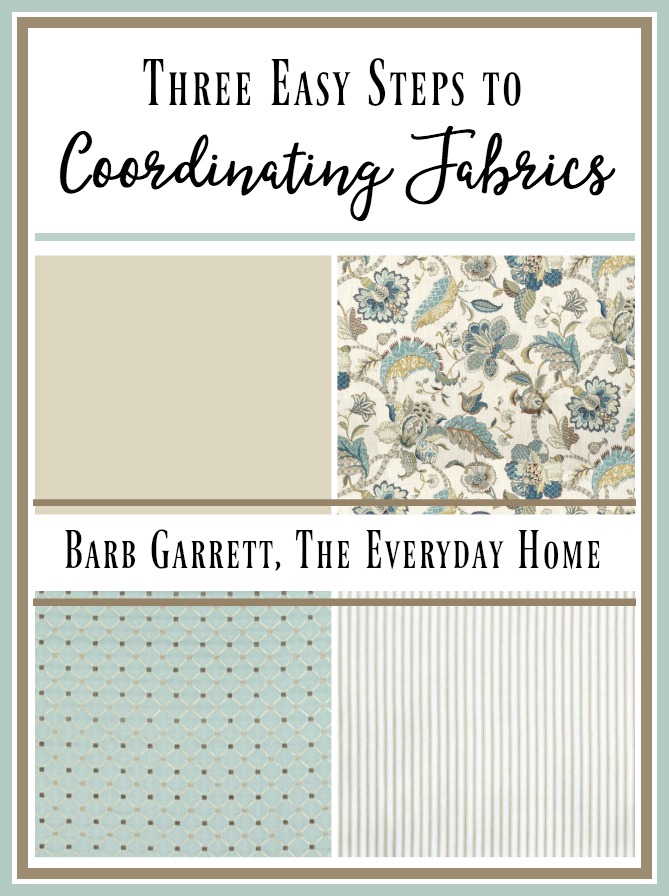
There are several factors to consider when you are trying to coordinate fabrics.
When you enter a large fabric store with row after row of beautiful fabrics it can be quite mind boggling. As a decorator, even I get overwhelmed. I always fall back on a few basic “rules,” and then everything just falls into place. I have outlined these three basic steps for Coordinating Fabric below, and I know it will work for you, too.
…………………………………………………….
Don’t forget – a new month means a new winner! Just comment to win.
One comment = one entry so comment as often as you like.

……………………………………………………………….

Have you ever looked at a room in someone’s home or on Pinterest and said to yourself…”self, I really love that combination of pillows or fabric, but I just can’t seem to pull that off.” Does this sound like you? Fret not, oh Confused Fabric Friend, I’m here to give you my no-fail Fabric Coordinating tips. First things first… you need to create a small “Design Diary.” It doesn’t have to be perfect, in fact my looks like a hot mess right now – hence why I am not sharing it. Ha! In fact, mine is a small notebook that fits easily in my purse with color samples and fabric samples. It’s very important to have your colors and coordinating fabrics with you at all times, so when you run across a great fabric (or pillow or decor accessory) you are not playing guessing games.
…………………………………………………………………

1.) COLOR: The first element to consider when coordinating fabric is the obvious – color. The colors of the fabrics must present a cohesive package that compliment each other – not compete.
2.) PATTERN: The second element is pattern. Fabrics generally fall under one of two patterns – curvy or straight. A sample of a curvy pattern is a damask. There is no set pattern, but more of a “wave” of color and design. An example of a straight pattern is a plaid. There is a definite pattern that is easily recognizable throughout the fabric.
3.) SIZE: The third consideration is size. When speaking of size, I am referring to the size of the overall pattern, and not the actual width. Sizes, or the scale of fabric patterns fall under small, medium or large categories. For example, I will use a Jacobean fabric to further explain.
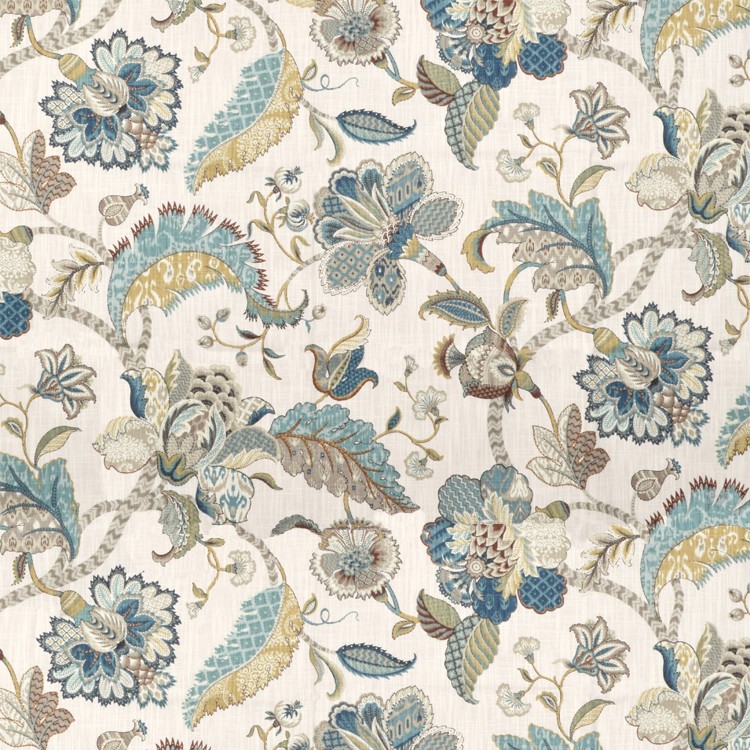
(P. Kaufman Finder’s Keepers in French Blue)
When you look at a fabric such as this, you would immediately assume that the fabric is considered a large print. This may be true but what happens when you pair this fabric with a larger scale plaid? The “large” jacobean print seen above becomes a “medium” pattern. In other words, the size and scale of the fabric may be determined by the other fabrics.
……………………………………………………………………..

Let’s just say, for the sake of explanation, I have a room that I need to furnish with window treatments, pillows, accessories, etc. This room is a Living Room which has been painted SW Maison Blanche.
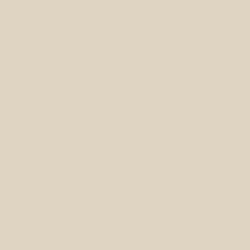
The sofa is a solid tan, and the focal point of the room is a beautiful floral rug which features a tones of tan, blues and greens. I am walking down the aisles of the fabric store, and then I stop! There is the fabric I want. It’s the beautiful Jacobean fabric above. It consists of all the colors in the rug, but best of all – it features a myriad of colors which will provide a basis for coordinating other fabrics. This floral fabric will become my Anchor fabric.
…………………………………………………………………..

Let’s Analyze the Anchor Fabric…

The anchor fabric is the fabric that will be used most often throughout the room, or the predominate fabric. This fabric will be used for the window dressings, and maybe to upholster a small chair and/or ottoman. I recommended that your anchor fabric consist of no less than three colors.
1.) COLOR: The anchor fabric features a minimum of three colors. It will compliment my both my walls and sofa, and work well with my area rug.
2.) PATTERN: This fabric has no set pattern, so it would be considered a curvy pattern.
3.) Size/Scale: I will need to coordinate the other fabrics before determining this element.

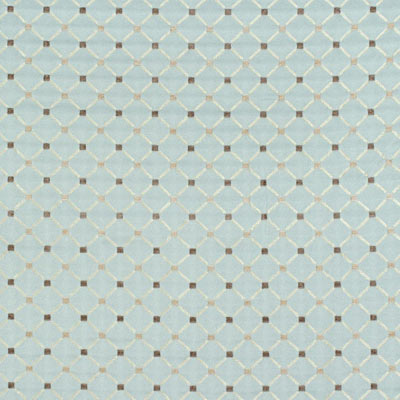
The secondary fabric, a geometric pattern, is the fabric that I like to use for medium-sized pieces of furniture such as side chairs, club chairs, etc. – or maybe even smaller pieces like seats of dining room chairs. The secondary fabric can also be used on such items as a bedskirt and shams in coordination with the anchor fabric. This fabric, when paired with the anchor fabric, should complement the room’s decor and should not become the focal point fabric.
Let’s Analyze the Second Fabric:
1.) COLOR: The three colors of the secondary geometric fabric which I have chosen incorporate all three colors from my room’s color scheme. It also compliments the colors found in the anchor fabric.
2.) PATTERN: The pattern above features a primarily straight pattern. Paired next to the curvey plaid, it will not overwhelm the eye with too much pattern.
3.) SIZE/SCALE: In relation to the anchor fabric(the chintz) the plaid would be considered medium in size.

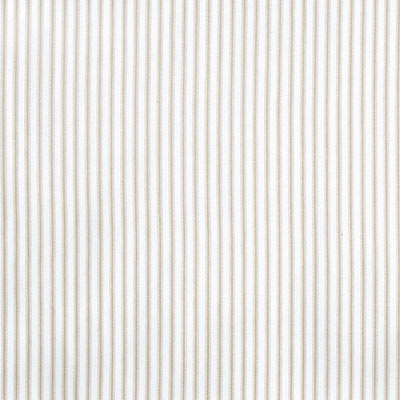
The accessorizing fabric is used sparingly around the room in spurts of color. It is meant to be the “finale” of sorts for the “show” that is being produced by the anchor and secondary fabrics. Since you will use this fabric on a limited basis, it makes it possible to splurge on more elegant and luxurious fabrics as brocades, velvets, chenilles and jacquards. It is possible to have more than one accessorizing fabric.
Let’s Analyze the Accessorizing Fabric
1.) COLOR: The color is one of the three colors in the chosen scheme. It matches the color of the sofa, except it is featured in an alternate texture. The color will allow it to blend with the sofa, yet the texture will allow it to have its own personality.
2.) PATTERN: The pattern, a stripe, compliments both the jacobean and the geometric without
3.) SIZE/CONTRAST: In comparison to the larger Jacobean pattern and the medium geometric design, the scale of this stripe would be considered small.

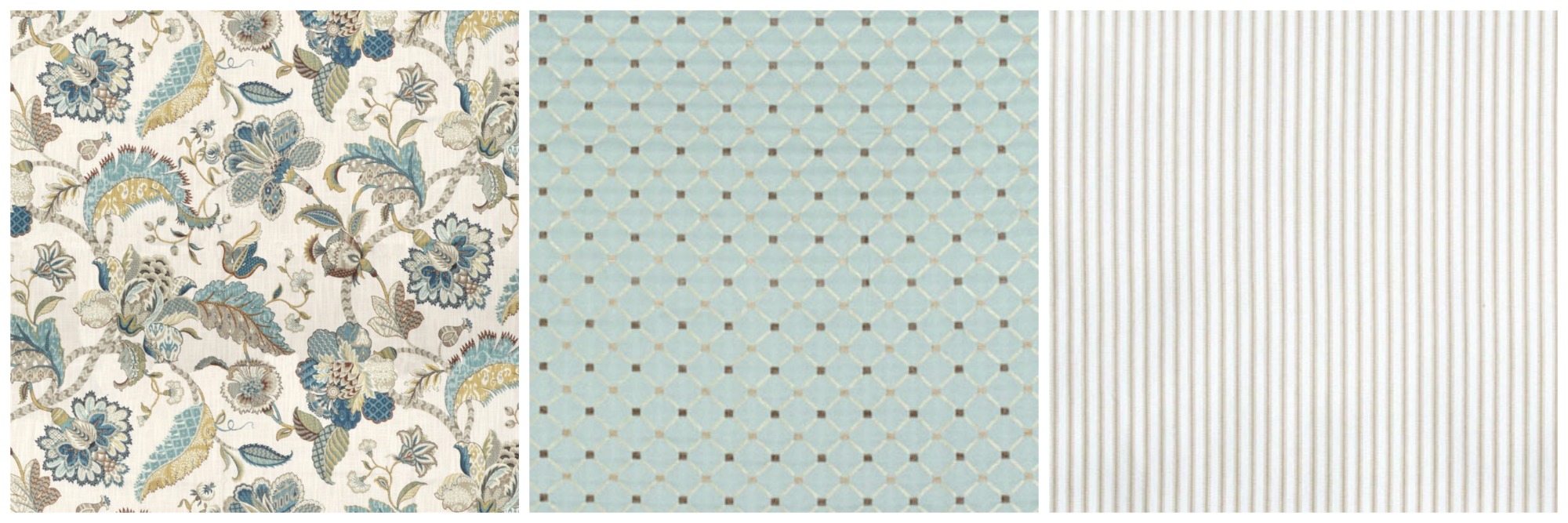
Here, you see all three chosen fabrics together – the Jacobean, the Geometric and the Plaid. You can see how well each fabric compliments the other. To review the fabric coordination, you will see that:
COLOR:
There is a recognizable color scheme. Using this color scheme, I can choose other accessories such as candles, flowers, etc. I can also choose to carry these same three colors throughout the home, or – I can choose another complimentary color from the anchor fabric to use in an adjoining room.
PATTERN:
As I mentioned before, fabric patterns are generally considered either curvy or straight. It’s important that you do not use fabrics which are closely related in pattern, for example two curvy fabrics or two straight patterns. It is imperative that each fabric as a whole does not compete with each other. Coordinating fabrics simply by color isn’t enough. You can have three color coordinated fabrics which flow well together, but if the scale or patterns are similar or clash, you will not have the same effect.
SIZE/SCALE:
When I described the elements of pattern, I said that all most fabrics fall under the category of small, medium or large. The large is the Jacobean, the medium is the Geometric and the small is the Stripe. Some designers might say that you need one of each for a well-rounded and coordinated room. I tend to disagree. I think it is possible to have a selection of fabrics that fall under a medium, medium, small pattern – just to name an example. For instance, let’s say I had chosen a medium scale check as my Secondary fabric, versus the Stripe. Then, my fabric patterns would be large, medium, medium. I think that as long as the scale of all fabrics work in close relationship to each other, you can use any combination. What I would not recommend is to use two or three large size prints and suddenly try to throw in a mini scale print. This will seem too off balance and the mini print will look out of place.
I hope this has helped to take out some of the confusion of coordinating fabrics. I realize that this can be one of the hardest steps when it comes to decorating a room because unlike a gallon of paint, which you may have purchased for $30 or less, you are talking about a major expense when it comes to purchasing enough fabrics to decorate an entire room – or even a single project such as window treatments. I would also like to suggest the following: if you are trying to match fabrics to either walls, wallpaper, furniture or other fabrics – do not rely on those itsy-bitsy pieces of fabric which stores supply as “swatches.” Go ahead and purchase at least an 1/8 of a yard. This way, you can take the fabric home, lay it out on the sofa or tape it against your wall. By doing this, you will get a true feeling for the fabric. A small swatch can be very deceiving because you do not always get the total picture or the pattern repeat – and often, several colors that are featured in the fabric are not even represented in the small swatch. By the way – this is my same philosophy as far as those tiny paint chips are concerned. They, too, can be deceiving. Although you may spend a little more in the long run, go ahead and purchase a sample size or quart of the color you have chosen, take it home and apply it to the walls, etc, in small areas. (make sure you apply TWO coats so the original color does not affect the true color.)
Thanks for letting me share How to Coordinate Fabrics with you!
xxoo, Barb
……………………………………………………..
Did this help you better understand how to coordinate fabrics?
I’d love to know what part helped you the most, please leave a comment below.

Do you follow me on Pinterest, Facebook, Twitter & Instagram?
I would love for you to Pin & Share this image on your fave social media sites.
Simply scroll the center of the image and click the icons of your choice.
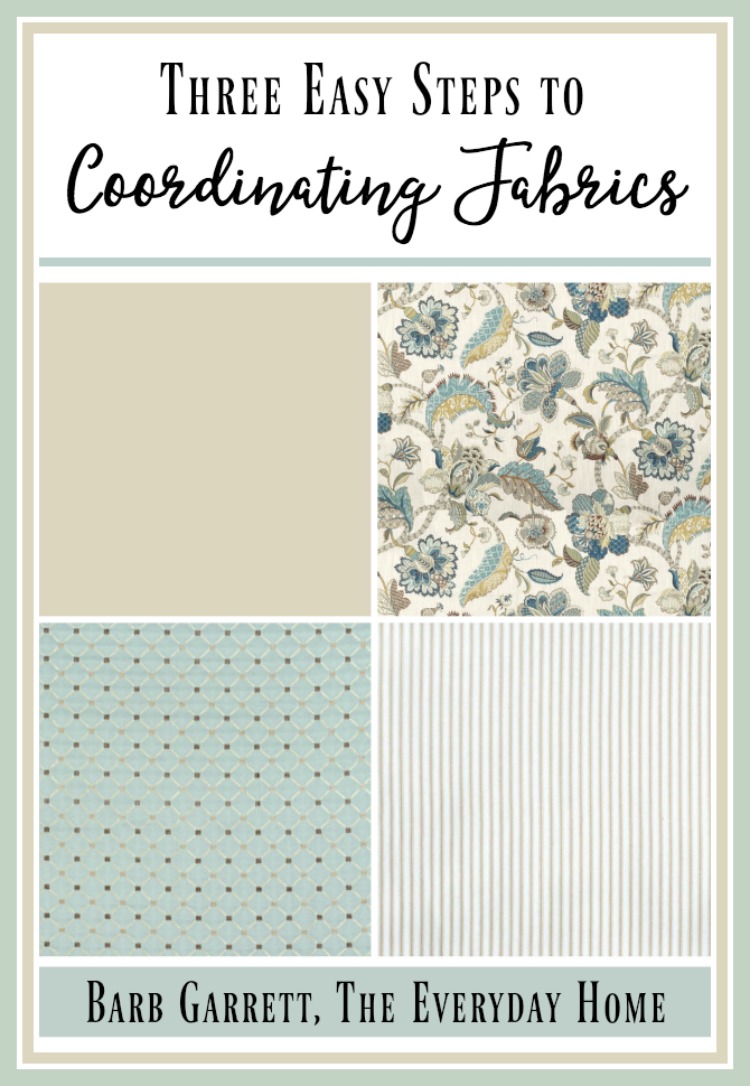
……………………………………………
Thank you for spending a few
minutes of your day here with me.
You can follow along with
The Everyday Home here….
PINTEREST FACEBOOK TWITTER INSTAGRAM
Here are some of the Link Parties I may be sharing this post with.
You can find more parties on my Linky Party Page.
” …finding joy in the everyday! “






That really helped me, Barb! Thank you! The part about the size of the patterns made sense to me….Didn’t think of it that way before! I LOVE fabric too! It just so happens I am going shopping tomorrow for fabric to make curtains.
View CommentI think that is where most people have issues, in the size and scale. Just keep that in mind when choosing fabrics. Good luck tomorrow. 🙂
View CommentThis really was exactly the advice I needed! I was completely lost as to how to coordinate fabrics and your site was full of straightforward instructions. I’m happy to report that it worked for me! It was easy shopping for the fabric when I had a plan to follow! Thanks so much Barb for this helpful guide!
View CommentExcellent explanation! Thank you.
View CommentGreat tutorial. Thank you. I am so patterned challenge. All of your points helped me a lot, especially with the patterns you showed as an example. I also scrapbook and your points are basically the same when choosing patterned paper. I will definitely save this to my Pinterest board. Have a great day.
View CommentI have a fabric addiction and have purchased one too many fabrics thinking that they would coordinate with eachother, get home and realize that the scale, color or pattern just didn’t work. Thank you for sharing your tips, I will definitely be carrying swatches from now on as well as a note with the three elements used to coordinate my fabrics! This article has surely helped me to head in the right direction!
View CommentGreat info!
View CommentThis was very helpful
View CommentThanks so very much for the timely advice! We just purchased a new to us home and I was really struggling to put it together. Thanks Barb for allleviating my cordinating confusion!!
View CommentThank you so much for explaining how to coordinate fabrics in a room. Yes, I did pin!
View CommentYou’re so welcome, hope it helped. Thanks for the pin!
View CommentThanks! from a coordinating challenged person. Your tips were appreciated.
View CommentNikki, Rosey, Exactly! I just don’t understand why doctors are so stubborn and oblivious at times. We pay them and entrust them with our health and they leave us mirofnismed. It’s so important to research beforehand. I wish I had done so. Sidenote: I’m feeling much better!
View CommentHi Barb, What a great explanation of how to coordinate fabrics! You’ve really broken down the information into understandable pieces. Thanks so much – I believe I’ll be better at doing this after having read your informative post! Blessings, Janet
View CommentThis post was very informative. It is so important to have your fabrics/colors with you because our mind can definitely play tricks on us. Thanks for this great information.
View CommentLove your book!!!!! Really…I am ready to pack up and go see Kate! Also, really like your blog and the fabrics you chose for this post….
View CommentThis is a great guide! I’m not very good at coordinating decor. Thanks so much for sharing with us at Funtastic Friday.
View Commentthanks for the help with material and patterns and prints, I am a paisley print kinda of person and love to make that my main fabric, would use paisley in every room and wear it too
View CommentGreat information.
View CommentThank you so much! this was awesome info! I am curious as to the names of the fabrics you discussed. Would you share the name of the designers and their color names for these 4 fabrics, Please?
View CommentHi Lisa – I actually wrote third article for my older website (The Everyday Decorator) several years ago. I doubt these fabrics are available any longer. Sorry. 🙁
View Comment